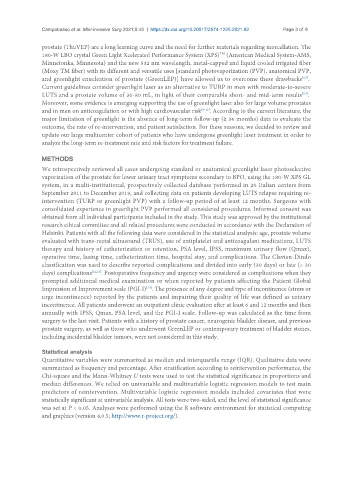Page 475 - Read Online
P. 475
Campobasso et al. Mini-invasive Surg 2021;5:45 https://dx.doi.org/10.20517/2574-1225.2021.92 Page 3 of 9
prostate (ThuVEP) are a long learning curve and the need for further materials regarding morcellation. The
TM
180-W LBO crystal Green Light Xcelerated Performance System (XPS) (American Medical System-AMS,
Minnetonka, Minnesota) and the new 532 nm wavelength, metal-capped and liquid cooled irrigated fiber
(Moxy TM fiber) with its different and versatile uses [standard photovaporization (PVP), anatomical PVP,
and greenlight enucleation of prostate (GreenLEP)] have allowed us to overcome these drawbacks .
[6,7]
Current guidelines consider greenlight laser as an alternative to TURP in men with moderate-to-severe
LUTS and a prostate volume of 30-80 mL, in light of their comparable short- and mid-term results .
[3,7]
Moreover, some evidence is emerging supporting the use of greenlight laser also for large volume prostates
and in men on anticoagulation or with high cardiovascular risk [8-11] . According to the current literature, the
major limitation of greenlight is the absence of long-term follow-up (≥ 36 months) data to evaluate the
outcome, the rate of re-intervention, and patient satisfaction. For these reasons, we decided to review and
update our large multicenter cohort of patients who have undergone greenlight laser treatment in order to
analyze the long-term re-treatment rate and risk factors for treatment failure.
METHODS
We retrospectively reviewed all cases undergoing standard or anatomical greenlight laser photoselective
vaporization of the prostate for lower urinary tract symptoms secondary to BPO, using the 180-W XPS GL
system, in a multi-institutional, prospectively collected database performed in 20 Italian centers from
September 2011 to December 2019, and collecting data on patients developing LUTS relapse requiring re-
intervention (TURP or greenlight PVP) with a follow-up period of at least 12 months. Surgeons with
consolidated experience in greenlight PVP performed all considered procedures. Informed consent was
obtained from all individual participants included in the study. This study was approved by the institutional
research ethical committee and all related procedures were conducted in accordance with the Declaration of
Helsinki. Patients with all the following data were considered in the statistical analysis: age, prostate volume
evaluated with trans-rectal ultrasound (TRUS), use of antiplatelet and anticoagulant medications, LUTS
therapy and history of catheterization or retention, PSA level, IPSS, maximum urinary flow (Qmax),
operative time, lasing time, catheterization time, hospital stay, and complications. The Clavien-Dindo
classification was used to describe reported complications and divided into early (30 days) or late (> 30
days) complications [12,13] . Postoperative frequency and urgency were considered as complications when they
prompted additional medical examination or when reported by patients affecting the Patient Global
[14]
Impression of Improvement scale (PGI-I) . The presence of any degree and type of incontinence (stress or
urge incontinence) reported by the patients and impairing their quality of life was defined as urinary
incontinence. All patients underwent an outpatient clinic evaluation after at least 6 and 12 months and then
annually with IPSS, Qmax, PSA level, and the PGI-I scale. Follow-up was calculated as the time from
surgery to the last visit. Patients with a history of prostate cancer, neurogenic bladder disease, and previous
prostate surgery, as well as those who underwent GreenLEP or contemporary treatment of bladder stones,
including incidental bladder tumors, were not considered in this study.
Statistical analysis
Quantitative variables were summarized as median and interquartile range (IQR). Qualitative data were
summarized as frequency and percentage. After stratification according to reintervention performance, the
Chi-square and the Mann-Whitney U tests were used to test the statistical significance in proportions and
median differences. We relied on univariable and multivariable logistic regression models to test main
predictors of reintervention. Multivariable logistic regression models included covariates that were
statistically significant at univariable analysis. All tests were two-sided, and the level of statistical significance
was set at P < 0.05. Analyses were performed using the R software environment for statistical computing
and graphics (version 4.0.5; http://www.r-project.org/).

